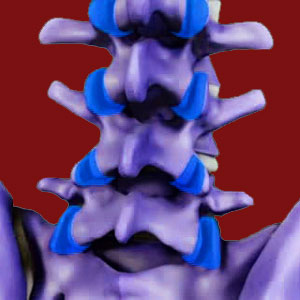
Ankylosing spondylitis facet joints are painful and often organically fuse, creating hypomobility and functional restrictions for the spine. Ankylosing spondylitis (AS) is an autoimmune disease that closely resembles rheumatoid arthritis in many ways, since it creates inflammation, visual evidence of its existence and a host of potentially debilitating effects. Much like RA, it is also highly unpredictable, with individual cases progressing or going into remission without logical explanative factors in most instances.
Ankylosing spondylitis commonly targets the facet joints and can cause much of the spine to lock-up, becoming an immoveable column of solid bone. However, some cases do not progress this far and many will stabilize and limit effects on the patient, often with little or no permanent damage done.
This fascinating essay explores ankylosing spondylitis conditions in the spinal facet joints. We will explain AS and its causes, detail its symptoms and cover the standard methods of therapeutic care received by the majority of patients.
Ankylosing Spondylitis Facet Joints Origins
There are strong links between the occurrence of AS and the expression of a particular genetic marker called HLA-B27. However, as is common with genetic research, not all people who have ankylosing spondylitis show evidence of this gene and not all people who have the gene will develop AS. In fact, only a small number of people who demonstrate this gene will go on to express AS symptoms.
Ankylosing spondylitis is an autoimmune disease, which means that benevolent defense mechanisms which naturally exist in the body malfunction and attack the body’s own tissues in pathological ways. In the case of AS, the joints, bones, organs and several crucial systemic functions can all suffer assault. In the spine, the facet joints are a favorite target and ankylosing spondylitis activity can be found in small areas of the vertebral column, regionally or throughout the backbone, sometimes encompassing the entire spine.
Many doctors have established strong links between the development of AS and the mindbody processes. This relationship has been supported by excellent results treating the condition using purely mindbody methods of care, such as knowledge therapy.
Ankylosing Spondylitis Spinal Expressions
Ankylosing spondylitis ranges in severity from mild to extreme; so symptomatic expressions will often range greatly in degree, as well. There is certainly no “typical case”, although there are usual expressions in the facet joints which simply vary in severity from patient to patient:
Patients often experience stiffness and limited mobility combined with pain as initial expressions of AS. Progression of symptoms usually includes inflammation that is visualized externally. The joints of the spine become swollen, hypertrophic and gnarled looking. Sometimes, secondary curvatures will develop in the side-to-side plane (scoliosis) and often, excessive curvatures will develop in the front-to-back plane, such as hyperlordosis or hyperkyphosis.
Patients with continually progressing conditions will usually suffer organic fusion of the spine at affected levels, creating ever-decreasing range of movement, increasing pain and markedly enhanced chances of suffering fracture or other serious injury, since the fused spine will now be incredibly susceptible to stress and impact.
Nerve compression within the central and neuroforaminal canals is commonplace in advanced cases of spondylitis.
Therapy for Ankylosing Spondylitis Facet Joints
Virtually all therapies which are designed specifically for spondylitis are governed by the traditional medical establishment. Few complementary caregivers focus on treating the condition, although many will provide support services that can be quite useful for providing relief.
The major focus on treatment efforts uses pharmaceutical products, often in cocktails of drugs, to treat the effects of the condition and slow its progression. The drugs used to treat AS are toxic and often have wide-ranging collateral side effects on general health and wellness.
Physical therapy is typically employed and has varying degrees of success, depending on the particulars of the patient’s condition and pattern of progression. Self-managed exercises, stretches and fitness activities are encouraged in patients who can perform these exertions.
In some cases, facet joint surgery is used to treat the consequences of ankylosing spondylitis, including laminectomy, foraminotomy and various facet joint techniques, as well as corpectomy, spinal implant placement and spinal fusion. No surgical endeavor will affect the disease itself in terms of providing curative benefit or retarding progression, but these procedures can be used to manage the collateral consequences of the disease, often multiple times during the patient’s life.
As mentioned earlier, some care providers have seen the generally disappointing results from most treatments and have completely changed their approach to embrace a mindbody model of care. By implementing knowledge therapy techniques, many patients have been able to stop progression, reverse progression and even completely cure their spondylitis conditions. Research must continue to determine if this therapeutic path will be universally beneficial or only useful in select cases of presentation. Since there are no risks, every attempt should be made to integrate this therapy into the treatment routines of every patient.
Facet Joint Pain > Causes of Facet Joint Pain > Ankylosing Spondylitis Facet Joints





